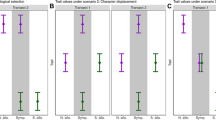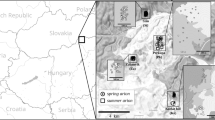Abstract
Studies on 2 sympatric morphologically identical populations ofAphytis mytilaspidis Le Baron frpm Greece were conducted on their mating behavior, reproductive isolation, hybridization in the laboratory, host preferences and adult survivorships at different temperatures. These studies revealed that the 2 populations were partially reproductively isolated and qualify at least for the rank of strong “semispecies” with respect to one another. Marked differences were also recorded in their host preferences and adult survivorships at different temperatures. Gene flow among these populations in nature is likely to occur only in one direction. Differences in host preference may further reduce gene flow by providing ecological reproductive isolation. Also hybrid sterility is indicated which if complete would prove these 2 forms to be sibling species. Based on the experimental evidence, an hypothesis is presented that these 2 populations represent a case of incipient if not complete sympatric speciation, with the presumed descendant population (R-69-120) possessing a broader host range and better adult longevity, in comparison to the proposed progenitor population (R-63-63-4).
Résumé
L'étude de deux populations sympatriques identiques au point de vue morphologie deAphytis mytilaspidis Le Baron originaires de Grèce a été réalisée à propos de leur comportement d'accouplement, leur isolement sexuel, leur hybridation en laboratoire, le préférence en hôtes et la longévité des adultes à différentes températures. Il apparaît que les deux populations sont partiellement isolées au point de vue reproduction et peuvent être qualifiées au moins de «demi espèces» l'une par rapport à l'autre. Des différences notables se manifestent également dans les préférences pour tel ou tel hôte et dans les survies des adultes selon les températures. Le flux de gènes dans ces populations dans la nature se produit vraisemblablement seulement dans une direction. Les différences dans les préférences vis-à-vis des hôtes peuvent en outre réduire le flux de gènes en assurant un isolement écologique de la reproduction. La stérilité des hybrides si elle était complète prouverait que ces deux formes sont des espèces sœurs.
A partir de ces faits expérimentaux l'hypothèse est formulée que ces deux populations correspondent à un début sinon à une spéciation sympatrique complète, avec une population descendante présumée (“R-69-120”) ayant une gamme d'hôtes plus large et une plus grande longévité imaginale par rapport à la population proposée comme géniteur (“R-63-63-4”).
Similar content being viewed by others
References
DeBach, P. — 1964. Some species ofAphytis Howard [Hymenoptera: Aphelinidae] in Greece. —Ann. Inst. Phytopath. Benaki, N.S. 7, 5–18.
— — 1969. Uniparental, sibling and semispecies in relation to taxonomy and biological control. —Israel J. Entomol., 4, 11–28.
Doutt, R.L. — 1956. Biological control of fig scale. —Calif. Agric., 8, 73.
Huffaker, C.B. — 1956. Spread and activity of imported parasites of fig scale. —Proc. 10th Ann. Calif. Fig. Inst., 23.
— — 1975. Mating behavior and evidence of a male sex pheromone in species of the genusAphytis Howard [Hymenoptera: Aphelinidae]. —Ann. Entomol. Soc. Am., 68, 893–896.
Khasimuddin, S. &DeBach, P. — 1976a. Hybridization tests: A method for establishing biosystematic statuses of cryptic species, of some parasitic Hymenoptera. —Ann. Entomol. Soc. Am., 69, 15–20.
— — 1976b. Biosystematic status of 3 allopatric populations ofAphytis maculicornis (Masi) [Hym.: Aphelinidae]. —Entomophaga, 21, 81–92.
Levene, H. — 1949. A new measure of sexual isolation. —Evolution, 3, 315–321.
Mayr, E. — 1963. Animal Species and Evolution. —Harvard University Press, Cambridge, Mass., 797 p.
Messenger, P.S. &Van den Bosch, R. — 1971. The adaptability of introduced biological control agents. In: Biological Control (Huffaker, C.B. ed.). —Plenum Press, New York, London, 68–89.
Rao, S.V. &DeBach, P. — 1969a. Experimental studies on hybridization and sexual isolation between someAphytis species [Hymenoptera: Aphelinidae]. I. Experimental hybridization and an interpretation of evolutionary relationships among the species. —Hilgardia, 39, 515–553.
— — 1969b. Experimental studies on hybridization and sexual isolation between someAphytis species [Hymenoptera: Aphelinidae]. II. Experiments on sexual isolation. —Hilgardia, 39, 555–567.
— — 1969c. Experimental studies on hybridization and sexual isolation between someAphytis species [Hymenoptera: Aphelinidae]. III. The significance of reproductive isolation between interspecific hybrids and parental species. —Evolution, 23, 525–533.
Rossler, Y. &DeBach, P. — 1972a. The biosystematic relations between a thelytokous and an arrhenotokous form ofAphytis mytilaspidis (Le Baron) [Hymenoptera: Aphelinidae]. I. The reproductive relations. —Entomophaga, 17, 391–423.
— — 1972b. The biosystematic relations between a thelytokous and an arrhenotokous form ofAphytis mytilaspidis (Le Baron) [Hymenoptera: Aphelinidae]. II. Comparative biological and morphological studies. —Entomophaga, 17, 425–435.
Schlinger, E.I. &Doutt, R.L. — 1964. Systematics in relation to biological control. In: Biological Control of Insect Pests and Weeds (DeBach, P., ed.). —Chapman & Hall, London, 247–280.
Stalker, H.D. — 1942. Sexual isolation studies in the species complex ofDrosophila virillis. —Genetics, 27, 238–257.
Author information
Authors and Affiliations
Additional information
This study was a part of the Ph. D. dissertation of the senior author submitted to the University of California, Riversiae. Financial support through grant Nos. GB 7444 and GB 17829 of the Nional Science Foundation awarded toP. DeBach is gratefully acknowledged.
Rights and permissions
About this article
Cite this article
Khasimuddin, S., DeBach, P. Biosystematic and evolutionary statuses of two sympatric populations ofAphytis mytilaspidis [Hym.: Aphelinidae] . Entomophaga 21, 113–122 (1976). https://doi.org/10.1007/BF02372022
Issue Date:
DOI: https://doi.org/10.1007/BF02372022




